Foolish Things in a Christian world - The Ruin of Public Health
Medical science – before and after the triumph of the Church
“God hath chosen the foolish things of the world to confound the wise; and God hath chosen the weak things of the world to confound the things which are mighty.”
– 1 Corinthians 1:22,27.
St Paul talked the talk. Humanity had to walk the walk.
'Pagan'

Surgery
Roman surgical instruments
2nd – 3rd centuries AD yet almost indistinguishable from their 21st century counterparts.

Eye Surgery
Roman suction couching needle for removal of cataracts (shown next to a modern electric suction needle)!
Through an extremely fine inner tube a Roman surgeon could suck the cataract out of his patient’s eye.

Herbal Wisdom
Fragment from De Materia Medica by Dioscurides – 6th century copy of 1st century AD herbal guide. It was prepared for Julia Anicia, daughter of emperor Olybrius (472).
The guide detailed 500 herbs and their usage.

Fragment from 4th century AD herbal guide
The Roman/Greek world had an extensive knowledge of herbalism.
Dentistry
Roman false teeth, set in gold. 3rd century AD.
The rich diet of wealthy Romans ruined their teeth.
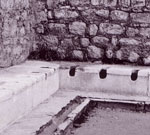
Sanitation
Roman public flushed toilets, Ephesus, 1st century AD.
By 315 AD Rome had 144 public toilets which were flushed clean by running water.

‘Valetudinarium’
Roman Military Hospitals
During the reign of Marcus Aurelius the first true hospitals were built to serve the needs of the Roman army.
They had separate wards, operating theatre, kitchens, baths, latrines, dispensary, mortuary and even a herb garden.

Childbirth
Relief showing Roman birthing stool.
2nd century AD.

Hygiene
Bath houses were a feature of all Romano-Greek cities.
Here, an illustration of Hadrian’s Baths, Leptis Magna (North Africa).

Repair
2nd century AD. Traction tables used to put tension on a displaced bone or joint, such as a dislocated hip, to realign the bone correctly
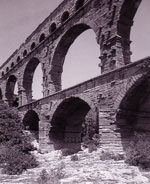
Clean Water
1st century AD – aqueducts bring fresh water hundreds of miles. Public baths and a culture of daily bathing kept many diseases in check.
Contrary to popular understanding, for most of their length Roman aqueducts ran underground, in sealed earthenware pipes similar to modern water mains.
'Christian'
Butchery
1100 AD
Christian cure for illness – cauterising!
The idea was that the blister caused by a hot iron would draw out a bad ‘humour’.

Prudery
1300 AD
Christian medical journal.
The patient keeps his drawers on!

Stupidity
15th century
Astrology and numerology passes for medical science.
Any lingering ancient wisdom relating to the medicinal value of plants was persecuted as witchcraft.

1400 AD
‘Cupping’
Heated glass bowls used to draw the blood

1500 AD
‘Bleeding’
Cure-all for centuries. Leeches often used.

16th century AD.
Emptying the potty in Christian Europe
” Because of frequent rains, the streets of the city of Nürnberg are full of garbage and other wastes flushed by the rain water, so that the rider has always to worry that the horse will fall in a deep layer of the dirt and will look and smell like a dirty swine or that his clothes will be stained by the mud splashed by other horsemen.”
M. Strell (Die Abwasserfrage)
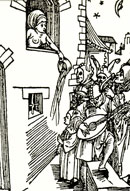
1600 AD
Approved clothing for dealing with plague victims – no kidding!
The beak was filled with sweet-smelling herbs.

1700 AD
Birthing – with all due decorum!

Pieces of wood – a medieval ‘cure’ for V.D.
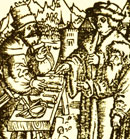
“Theriac” – dried and powdered snake.
Useless ‘cure-all’ for centuries

19th century – water carriers hawk buckets in teeming city streets.
The water source – a stand pipe, drawing water from sources polluted with human waste – worked delightfully well in spreading cholera and typhoid.

The Greek Achievement
Medicine in the Ancient World
In the 2nd century AD medical knowledge and surgical skill reached a level never achieved again until the early 20th century.
In the centuries in between a malevolent religion – Christianity – presided over the destruction and misery of humanity.
Gods dominated the lives of the Greeks but Greek physicians nonetheless tried to find a natural explanation for illness. Medicine, as opposed to hocus-pocus, was practiced at least as early as 1000 years BC.

Hippocrates of Cos (460-377 BC), is credited with being the first to separate medicine from rekigion and disease from the supernatural. He is best remembered for his Oath of Medical ethics, still honoured, in modified form, today.
The gods had a role to play, of course. Apollo was consulted, as was Asclepios and his two daughter goddesses Panacea and Hygieia. Science and superstition coalesced at temple/hospitals – asclepeia – built at places such as Epidaurus, Corinth, Cos and Pergamon. They offered an ‘holistic’ approach to sickness: hot baths, sleep and meditation coupled with prayer and medical treatments. Written accounts have survived of those who were cured.
In the 3rd century BC Alexandria emerged as the most important centre of medical research. Its schools of study enjoyed international reknown and attracted the finest minds. Alexandrian scholars were able to take advantage of officially approved dissection and Egyptian burial practice (which removed and preserved the internal organs). The zoological gardens provided animal specimens.
One of Alexandria’s earliest physicians, Herophilus (335-280 BC), collected and compiled a group of medical treatises known collectively as the Hippocratic Corpus, to which he added studies of his own. He identified the brain as the centre of intelligence, linked to the nervous system, and the function of the heart in the circulation of blood.
His successor Eristratos concentrated on the digestive system and postulated that nutrition as well as nerves and brain influenced mental diseases. Eristratos was the first to distinguish between sensory and motor nerves.

Alexandria’s centuries of research into human physiology and illness reached its zenith in the second century AD, with Galen of Pergamon (129-216), who contributed a lifetime of his own investigations. His treatments involved wine-based anticeptics, the stitching of wounds and sterilised hand-crafted surgical instruments made from ‘fine iron.’
Raised to the status of personal physician to the emperor Marcus Aurelius, Galen wrote hundreds of books on anatomy and the art of medicine, which formed the corpus of medical knowledge of the Roman world.
Sources:
Peter Murrey Jones, Medieval Medicine (The British Library, 1998)
I. Loudon (Ed.), Western Medicine (Oxford, 1997)
David Keys, Catastrophe (Century, 1999)
John Julius Norwich, Byzantium (Viking, 1988)
Charles Freeman, The Closing of the Western Mind (Heinemann, 2002)
Jenifer Cochrane, The Illustrated History of Medicine (Tiger Books, 1996)
Norman Cantor, In the Wake of the Plague (Pocket Books, 2001)

Dressed corpse (Capuchin vaults, Palermo).
Medieval obsession with death included the display of clothed corpses.
In stark contrast, the ancient Greeks celebrated the healthy, perfected human form.

Asclepios
By observing basic rules of sanitation and hygiene, and with doctors attached to the legions, military hospitals, and even field medics, a Roman soldier was more likely to survive conflict than any other soldier until the First World War.
Biblical Guidelines –
Avoid Water!
“Drink no longer water, but use a little wine for thy stomach’s sake and thine often infirmities.”
– St Paul (1 Timothy 5.23)
Prayer and Oil!
“Is any sick among you? let him call for the elders of the church; and let them pray over him, anointing him with oil in the name of the Lord:
And the prayer of faith shall save the sick, and the Lord shall raise him up.”
– James (5.14,15)
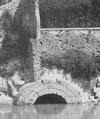
Cloaca Maxima
Rome’s ‘main drain’. Originally built in the 6th century BC, it was extensively rebuilt in the 1st century BC.
The sewer is still in service more than 2000 years later.
In contrast, in Christian Europe, as late as the 17th century, open sewers – water ditches, running alongside city walls – were the only drainage almost everywhere.

Broken
One tactic of siege warfare was to cut the water supply to a walled city.
Where the mighty aqueducts were broken the still flowing water formed extensive bogs.
Rapidly these new swamps became a breeding ground for malaria-carrying mosquitoes.
